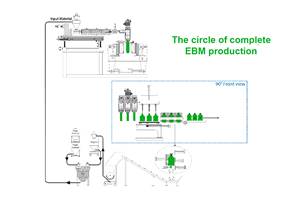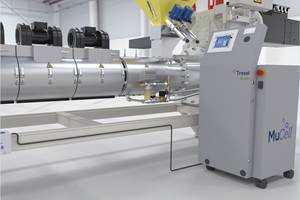Advanced Styrenic Lets Molder Shed New Light On Automotive Part
Polyoptics teamed up with Styrolution to develop a ‘breakthrough’ process for light guides.
An emerging leader in optical technology, has pioneered new technology to injection mold light guides in a single step without any refinishing operations. A high-precision tool insert with a complex laser-processing transverse uncouple structure reduces the production time of a light guide by two-thirds.
These guides are used in applications such as backlight effects in automotive interiors.
Based in Kleve, Germany, the company partnered with global styrenics supplier , Aurora, Ill. , on a “breakthrough” technology in this arena, and a new advanced styrenic material was instrumental in its success.
The key purpose of the project was to optimize—both in production time and quality—the current process for manufacturing light guides. That process consists of three successive steps that take a total of 3 minutes: production of transparent plastic plates using extrusion or calendering; cutting light-guide shapes out of the plates with a laser; and creating the complex uncouple structure with laser processing. Moreover, Polyoptic estimates that the third step typically has a 50% failure rate. The new technology has a 60 sec/unit production time and a failure rate of just 8%.
Polyoptics’ technology consists of two major innovations: Optical simulation calculations to zero in on the optimal uncouple structure pattern; and precision tool inserts made via laser processing or laser lithography. The former was used to investigate different uncouple structures. Arrangements of spherical caps, disks, and/or prisms are suitable for light guides. The structures could be either raised or embedded in the guide. The shape, density, angles, and depth of the structure depend on the guide’s geometry and the effect that is intended to be realized. With increasing distance from the light source, the height and diameter of the elements increase to achieve a homogeneous luminous density distribution.
The diamond-turning process used to produce other precision tool inserts is limited by the size of the diamond and the geometry of the “hole to be dug,” says Polyoptics. In case of the light guide, this method is not suitable because the elements are too tiny and the diamond would destroy the top edge of the hole. Reducing the size of the diamond is an option, but the smaller the diamond, the bigger the risk that it will break, Polyoptics explains.
Polyoptics’ first light guides were manufactured using PC. But in 2014, the firm tested Styrolution’s NAS styrene-methyl methacrylate-copolymer. Compared with PC, NAS showed advantages in both processing and optics. Its better flow leads to lower energy consumption and shorter cycles and makes it easier to fill out more complex, thin-walled shapes. The higher light transmission of NAS increases the luminous density, optimizing the output of the light guides without increasing the power of the light source.
Polyoptics’ engineers say their new technology is perfect for high-volume manufacturing and a perfect fit for automotive, especially for interior lighting. Polyoptics is in negotiations with automotive OEMs to apply its new light-guide technology to doorsteps and ambient lighting for controls and instruments. There is also interest from other industries like electronics.
Polyoptics offers optical engineering, ultra-precision tooling, production, and optical coating. Polyoptics molds the light guides on presses with clamping forces from 25 tons up to 500 tons. All are equipped with automation systems in a cleanroom environment.
Related Content
US Merchants Makes its Mark in Injection Molding
In less than a decade in injection molding, US Merchants has acquired hundreds of machines spread across facilities in California, Texas, Virginia and Arizona, with even more growth coming.
Read MoreGet Color Changes Right In Extrusion Blow Molding
Follow these best practices to minimize loss of time, material and labor during color changes in molding containers from bottles to jerrycans. The authors explore what this means for each step of the process, from raw-material infeed to handling and reprocessing tails and trim.
Read MoreMultilayer Solutions to Challenges in Blow Molding with PCR
For extrusion blow molders, challenges of price and availability of postconsumer recycled resins can be addressed with a variety of multilayer technologies, which also offer solutions to issues with color, processability, mechanical properties and chemical migration in PCR materials.
Read MoreFoam-Core Multilayer Blow Molding: How It’s Done
Learn here how to take advantage of new lightweighting and recycle utilization opportunities in consumer packaging, thanks to a collaboration of leaders in microcellular foaming and multilayer head design.
Read MoreRead Next
Beyond Prototypes: 8 Ways the Plastics Industry Is Using 3D Printing
Plastics processors are finding applications for 3D printing around the plant and across the supply chain. Here are 8 examples to look for at NPE2024.
Read MoreMaking the Circular Economy a Reality
Driven by brand owner demands and new worldwide legislation, the entire supply chain is working toward the shift to circularity, with some evidence the circular economy has already begun.
Read More










